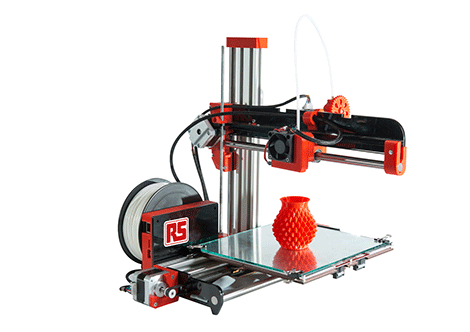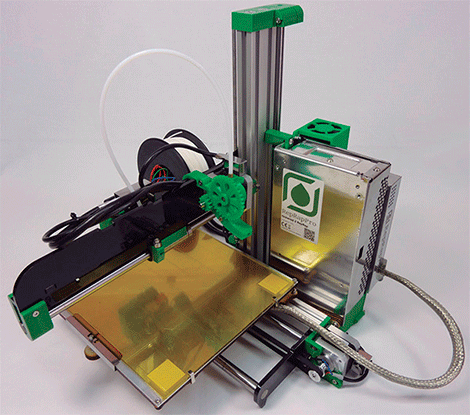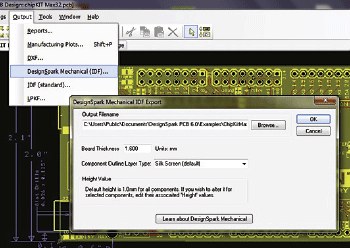3D printing is quickly becoming an essential part of the electronic design process. More and more companies are discovering the advantages of this technology to develop prototypes without having to lose months in the design cycle.
The cost of hardware and the lack of simple design software for non-CAD users held back its adoption. But now, the open source self-replicating RepRap 3D printer has evolved into a latest model, the Ormerod, which together with DesignSpark Mechanical 3D modeling software, gives companies and developers an excellent opportunity to speed up the development process. and encourage innovation, according to Mark Cundle, director of technical marketing at RS Components. Three-dimensional (3D) printing, or additive manufacturing as it has also come to be called, is revolutionizing product development and, in some cases, production itself. It is the process of manufacturing a solid object from a computer-aided design (CAD) model. For this, the additive manufacturing process is used, which basically accumulates successive layers of materials, such as plastics or metals, that are superimposed with different shapes. The more traditional machining technique uses a subtraction process, in which materials are removed much like sculptors chisel out a block of marble, as Auguste Rodin himself might have done in his day.
Although 3D printing seems like a revolutionary innovation of the last year, largely and unfortunately due to the echo among the press for the manufacture of weapons, this technique was already in its infancy in the 80s. Many 3D printing methods have been used, some such as Fused Deposition Modeling (FMD), which is currently the most common process for low-cost 3D printing, Stereolithography (SLA), Electron Beam Melting (EBM ) or laminated object manufacturing (LOM). These technologies are increasingly used for rapid prototyping and also in some manufacturing processes in many industries, such as engineering, construction, automotive, defense and aerospace development, medical applications, and different consumer markets. like fashion.
Greater presence in the market
With the new millennium, the sales of 3D printers have increased considerably, they arouse more and more interest and their attractive prices also help, the serial production models cost less than 2000 euros.
A recent market study, published by the consulting firm Markets&Markets, predicts a compound annual growth rate of 23% for 3D printers between 2013 and 2020, eventually reaching a sales volume of more than 6 billion euros.
3D printing is evolving from a specialized technology used primarily by large companies to a system geared towards the mass market of consumers and small businesses. In fact, there are opinion groups that maintain that 3D printers will end up finding a place in our homes to avoid the costs associated with the purchase of common household items. Technology is being quick to demonstrate its usefulness for any application, and thanks to it we will be able to create products on a small scale comparable to those produced by large companies. Joe Kraus, a pioneer in dotcom companies, spoke of all this quite aptly on BBC Radio 4's 'In Business' programme. He highlighted how innovative it really is for manufacturing and production processes: 'The 3th century is reduced to dozens of markets of millions of consumers. In the 100st century, it's millions of markets for dozens of consumers." The situation is this: XNUMXD printing, along with other technologies and platforms, such as open source, is destined to play an important role in a future that clearly points to XNUMX% custom solutions, instead of the old “make one product” approach. that works for everyone."
Rapid prototyping: hours, not weeks
3D printing is becoming an important place in the manufacture of products in many industries, particularly in low-volume or highly customized applications. However, this technology has its limits for large-scale production. 3D printing, based on layering, seems to lack the structural integrity needed to manufacture production components. It is therefore unlikely that 3D printing will replace the technology of manufacturing from cast liquid metal in the immediate future.
But perhaps the determining factor, at least for mass production, is 3D printing's ability to rapidly create prototypes. It is revolutionizing the methodology of product development since it is not necessary to study the operation of the machines to create prototypes. And this supposes a great advantage in terms of commercialization, in addition to greater freedom in the designs. The product development process has seen vast improvements in a number of industries, including automotive manufacturing, consumer electronics, and medical devices. 3D printing technology is being used to design and test new concepts in the small and large business arena, serving as an alternative to custom machine tooling for prototyping new components or parts. The method allows developers to have a prototype in a matter of hours or days, instead of the weeks or months that were previously required. But the advantages go beyond the mere saving of time and costs; the rapid development of prototypes with 3D printing is favoring the final manufacture of more innovative and higher quality products.
Developers no longer have to wait for tools and parts from machine dealers or injection molding shops. 3D printers allow prototypes to be physically tested, rectified and improved before materializing them into a final product for mass production.
RepRap and self-replication
A key point of 3D printing is open source and self-replication: what if a 3D printer could duplicate itself? Adrian Bowyer, a former professor of mechanical engineering at the University of Bath, UK, founded the Replicating Rapid Prototyper project, RepRap, in 2004.
The idea is to make 3D printing available to the general public at a reasonable or relatively low price. Ultimately, the RepRap project is an initiative to develop an affordable 3D printer that can print most of its own components. RepRap printers use 3D printing methods based on fused deposition modeling (FDM): a computer controlled plastic glue gun and a spool of plastic fed into a heated chamber.
The plastic material is applied with a tiny nozzle and the first layer is created, which is deposited on a base plate. The plate then lowers slightly to receive the second layer, and the cycle repeats itself. In his talks and conferences, Bowyer explains that the RepRap project establishes a symbiotic relationship between machines and people: machines are the flowers that produce fruit and people are the insects that pollinate these flowers that help the machines to grow. replicate.
Although the machine will be able to create all the plastic parts, RepRap specifies that the rest of the components necessary to obtain a "twin" machine, such as the electric motor, electronic systems and other parts such as metal threaded rods, must meet two premises: they must be relatively cheap and easy to obtain; and they must be readily available to everyone anywhere in the world.
A fundamental objective of RepRap is to make 3D printing accessible to everyone and, therefore, a central argument of the project is that it must be open source. Anything that can copy itself is subject to the laws of evolution; and as it is a machine that manufactures its own parts, the design files have to be fully available. However, the machine will not evolve by random mutation, it will be more the result of a selective process similar to the development of Linux and open source software.
The RepRap community will undoubtedly change the design to improve it, perhaps in a more accurate or developable version, and of course, many of these improvements will be published on the Internet. And if a user has an old RepRap machine, he can use it to create a new one from the improved design.
The project has been widely accepted: printers are available at an affordable price and most are based on the RepRap project. According to a recent survey on 3D printing (Manufacturing in Motion, Moilanen, J. & Vadén, T), the RepRap project had the largest market share. Furthermore, to further spread the concept, in 2011 RepRapPro emerged, the commercial arm of the RepRap project.
The first RepRap 3D printers were the Huxley and Mendel models, retailing for just a few hundred euros, and marketed as a kit of parts, with or without printed plastic components. And here is the new generation of RepRap, the Ormerod model.
RepRapPro Ormerod
RS brings to you the new and affordable RepRapPro Ormerod 3D Printing Kit. Together with free DesignSpark Mechanical 3D design software, the printer enables design engineers to develop sophisticated concepts and products with astonishing speed and cost-effectiveness. The Ormerod model is one of the most versatile 3D printers on the market, also suitable for small production runs. Its exceptional design makes it easy to add more features and is quick to duplicate and assemble.
Like its predecessors, the Ormerod uses the FDM process, also known as fused filament manufacturing, to create 3D objects from a variety of plastic materials and even an entire palette of colors. This process allows the user to create almost any shape that can be modeled on a computer, even some that cannot be reproduced using traditional manufacturing techniques. Although the Ormerod is actually a monochrome 3D printer set up to work with one type of plastic per object produced, the device's head is designed to support three-color deposition. An upgrade kit is expected to be released soon. In addition, the Ormerod's electronic board has been redesigned and now supports web browser connectivity. Likewise, its assembly is much simpler when compared to the Mendel model, for which it took an average of two days. By contrast, the Ormerod is ready in two hours, making it accessible to even the least advanced user.
The RepRapPro Ormerod is delivered with a parts kit with all necessary components, DesignSpark Magazine Issue 4 ready to assemble. Complete kit includes: all printed parts; hardware, including plain and threaded rods, screws, nuts, washers, straps, and bearings; electronic board programmed and already soldered; MicroSD card and adapter; heated PCB mounting surface; engines; injectors and extruder drive mechanism; 100 m of 17,5 mm diameter PLA (polylactic acid) filament material (about 300 g); power supply (for EU, UK, US and Australia); and finally, software for the operation of the machine, including the firmware for the electronic system. Other Ormerod specifications include an accuracy of 0,1mm, resolution of 0,0125mm, throughput speed of 1,8mm per minute, and deposition rate of 33cm3 per hour.
In short, 3D design and rapid prototyping are now within the reach of a greater number of users and are not just reserved for CAD experts. Therefore, the doors are opened to new innovations and a greater offer of products in the market in less time, all thanks to the combination of the low-cost 3D printing technology of the RepRapPro Ormerod, the free and easy-to-use software use DesignSpark Mechanical and the ModelSource library for 3D component models. The RepRapPro Ormerod is available from the RS website at rswww.com/RepRapPro and DesignSpark Mechanical is available for free download from the DesignSpark website at www.designspark.com.







